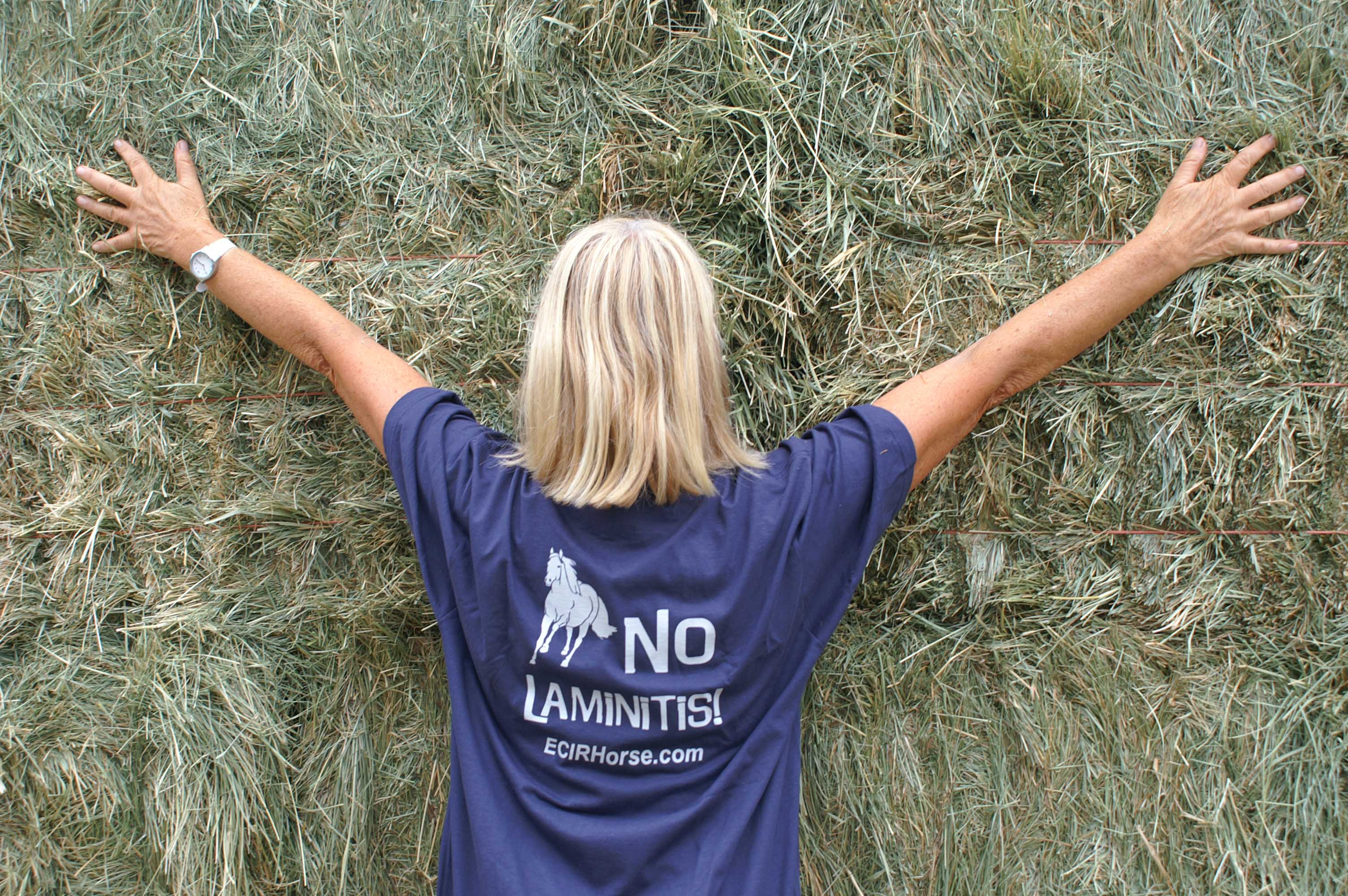Treatment of EMS and Insulin Resistance (IR) in PPID
Now that EMS has become the "disease du jour" the equine market has exploded with low-carb feeds and supplements to fix or cure this condition. Don't fall for it!
First, understand that EMS is not a disease: it is a "metabolic type". And the goal of the ECIR Group protocol is "no laminitis" ever again, with blood work as close to normal as we can possibly get — if not completely normal. The ECIR Group protocol is about a lifestyle change for your horse, i.e., a management change that owners need to be committed to. Fortunately, the horses are fine with the changes and it typically costs less than the "magic bullet" supplements on the market that don't work!
DIET IS KEY
It doesn't take a great leap to understand that effective weight loss comes with a controlled diet. If you have a "condition" or metabolism that does not tolerate high intakes of simple carbohydrates or fatty foods, it's not difficult to predict that the best diet will be a low-carb, low-fat diet. Humans have struggled with control of metabolic syndrome and weight gain far longer than equines have. A host of different medications have come and gone. Nothing works better for people than exercise and a controlled-calorie, low-carb diet. The horse is no different.
The learning curve for owners is to begin to understand what exactly a low-carbohydrate feed is, and how the owner can go about not only affecting weight loss but even reversing the cycle of insulin resistance (IR). The horse is very fortunate to have a unique digestive system where fermentation products of fiber in the hind gut can be either burned directly as energy sources or converted to fat or glucose once inside the body, essentially eliminating the need for high-carbohydrate and high-fat diets. The conversion of fermentation products takes place in the horse's liver.
In human IR, there is evidence of overproduction of glucose by the liver (gluconeogenesis), but by evidence to date this does not seem to be the case in horses — at least for the vast majority of horses. By providing calories predominantly in the form of fermentable fiber, there is little to no blood glucose spike associated with eating and the liver can control blood glucose levels by releasing glucose only when and if needed to keep blood levels normal.
How high blood sugar rises after eating any particular food is referred to as the glycemic index. The higher the sugar and starch content of a food, the higher the blood glucose will rise.
 Low ESC and Starch forage is the foundation for an EMS diet
Low ESC and Starch forage is the foundation for an EMS dietSome work has been done on establishing the glycemic index of common equine foods:
Through trial and error over the years, the ECIR Group has found that IR horses do best on hydrolyzable carbohydrates (HC) — Ethanol Soluble Carbohydrates (ESC) plus starch —dietary intake of no higher than a combined 10%. The ECIR Group has also found that some chronic IR horses may require this number be even lower to keep their high insulin in check.
Although low-simple-carb feed options are becoming increasingly available, the majority are higher than the 10% combined HC goal. By far the safest and least expensive grain substitute is plain beet pulp, with no molasses added. It was the lowest glycemic index food in the study linked above and when owners rinse/soak/rinse beet pulp, HCs can be as low as 5%.
Horse owners have been very well conditioned by feed companies to think of our horses' nutrition in terms of what is inside a feed bag. The missing key in horse owners' education is that hay is not just fiber: it is the single largest source of nutrients in the horse's diet. Hay is the major source of B vitamins, vitamin A, vitamin D, protein, minerals and calories, largely only deficient in Vitamin E, some trace minerals, and essential fatty acids.
The ideal diet for an insulin-resistant horse is a low HC grass hay with plain beet pulp to carry minerals, vitamin E, and essential fatty acids to complement that hay. Horses do not need a bagged feed, they do not need added fat, and they do not need protein supplementation in most cases.
It is not the overall HC in the total diet that matters;
it is the HC composition of each and every individual meal.
Horse owners would all benefit from learning to properly sample and interpret hay analysis. Through hay analysis, owners can test the ESC and starch content of their hay to determine suitability for their horses.
Some pertinent terms on hay analysis reports are:
- Water Soluble Carbohydrates (WSC): Includes simple and digestible sugars (sucrose, glucose, fructose), non-digestible simple plant sugars, and probably short chains of fructan (storage sugar for plants)
- Ethanol Soluble Carbohydrates (ESC): Simple sugars that can be extracted in a blend of ethanol and water.
- Starch
Two labs regularly used for testing by the ECIR Group are:
- www.equi-analytical.com (Test #603)
- www.alcanada.com (Equine Feed Test)
Please note that these labs are listed due to being the most frequently used by ECIR Group members. Other labs may be suitable but it would be wise to contact the lab in advance of submitting a sample in order to ensure that the ESC/Sugar and Starch tests are the same as the two listed. Not all labs will use the same tests for analysis of feeds.
For the IR horse it is the hydrolyzable carbohydrates – simple sugars (ESC extracted through feed analysis) and starch levels – that matter. These are the components that can cause a blood sugar and insulin rise. If not enough hay can be purchased at one time to justify feed analysis, the hay can be soaked in water to lower the sugar content before feeding. ESC/sugar levels may decrease by an average of 30%, based on one small study of a 30-minute soak in hot water, or 60 minutes in cold water. In general, the longer the soak time, the hotter the water, and the more water used, the greater the decrease of ESC/sugar will be.
As a starting point for the amount of hay to feed, give the horse either 1.5% of his or her current body weight or 2% of ideal body weight, whichever is larger. This is calculation is for horses that are not being worked, and may need to be adjusted up or down for some individuals.
Be aware that starvation diets DON'T WORK! Cutting calories too drastically will only worsen IR. This happens because the horse's body goes into a state of alert — a starvation warning. To conserve precious calories for key organs, IR is induced. This happens with starvation in all species, regardless of whether the individual was IR to begin with.
Mineral balancing is also very important for these horses. Magnesium is a good example. Adequate magnesium is critical to both burning of fuels and storage of energy in every cell. On the trace mineral front (iron, copper, manganese, zinc, selenium, chromium), the mineral patterns very commonly found in hays are not helpful for IR control. Copper, zinc and selenium are important antioxidant minerals but are commonly deficient.
With minerals, the amount you need to supplement depends on the total amount in the diet, the level of minerals that compete for absorption or worsen deficiency/toxicity, and the influence of any disease state the horse may have. The summary of recommendations below has also been published in the new textbook "Equine Podiatry" (Saunders/Elsevier) and in the February 2004 issue of the journal Compendium of Continuing Education for Practicing Veterinarians (Vol 26(2)).
- Feed 1.5% of current body weight or 2% of ideal body weight in low HC hay, whichever is greater. Adjust up or down as needed to maintain body condition score of 4.5 to 5.
- Feed adequate but not excessive protein.
- Vitamin E, 2 IU/lb of bodyweight (2,000 IUs for a 1,000 lb horse)
- Selenium, 1 mg/500 lbs of bodyweight unless in a high-selenium area.
- Iodine,1.75 mg/500 lbs of bodyweight.
- Plain salt, 1 oz/500 lbs of bodyweight plus free-choice plain white salt.
- Freshly ground or ground stabilized flax, 1.5 to 3 oz/500 lbs bodyweight.
- Balanced minerals.
Information Contained On This Page Adapted From
Equine Cushing's & Insulin Resistance Course
Offered by Eleanor M. Kellon, VMD www.drkellon.com
Gustafson, KM. Forage Analysis: How and Why, ECIR Group Inc., 2015 NO Laminitis! Conference, Austin, TX, USA. www.ivis.org
Kellon, EM. PPID and IR Myths and Misconceptions, ECIR Group Inc., 2013 NO Laminitis! Conference, Jacksonville, OR, USA www.ivis.org
Kellon, EM. Mineral NUTRITION and INSULIN RESISTANCE, ECIR Group Inc., 2013 NO Laminitis! Conference, Jacksonville, OR, USA www.ivis.org
Gustafson, KM, Forage Analysis: How and Why, ECIR Group Inc., 2015 NO Laminitis! Conference, Austin, TX, USA. www.ivis.org


